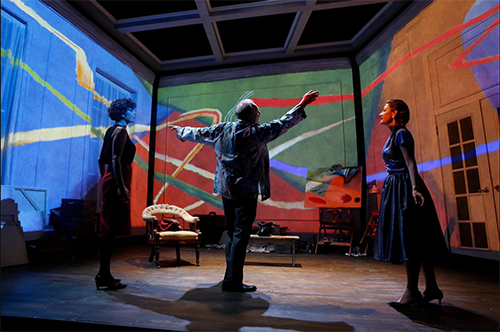By MARK BLANKENSHIP
When you're writing a play about a real person, where do you start? At the day she's born? At the moment he becomes "significant?" The entry point not only dictates the shape of your script, but also underscores who you are as a playwright.
Consider Lauren Gunderson's
Bauer, now at 59E59. Inspired by
modernist painter Rudolf Bauer, it stages his final days, when his career and reputation had been negated by a contract dispute that left his work locked in the basement of the Guggenheim Museum.
"That's pretty horrible for any artist," Gunderson says. "So there was this terribly dark, natural ending. But I'm not a dark playwright. I don't want to leave the theatre feeling devastated. I want to feel like I'm leaning forward, not looking down."
So instead of wallowing in his failure, Gunderson's play uses the end of Bauer's life to test the tenacity of his creativity. "It's not a play about a contract," she says. "It's about where art comes from. Where it goes. How we can get it back if we've lost it. Or can we?"
Those questions are filtered through Bauer's connection to two real-life women: Hilla Rebay (a baroness and fellow artist who was both Bauer's lover and professional champion) and Louise Huber (who began as Bauer's maid but became his wife in 1944). In the play, Louise arranges a meeting between Hilla and Bauer after a long estrangement, and the result forces all of them to reckon with what they've become.
For Gunderson, those relationships capture how lust and love fuse with artistic impulses. "I got to play with the stickiness of jealousy and desire and people who still love despite a lifetime of battle," she says, adding that this reflects how Bauer and his contemporaries approached their work. "Their art was a spiritual undertaking. They thought of their job not as 'I'm gonna go paint this mountain' but as 'I'm gonna paint something unseen before.' That's an emotional state. That's fiery."
These collisions are fundamental to
Gunderson's work, which has become a staple of theatres across the country. (She received five world-premiere productions last season alone.) "My plays often deal with the struggles around mortality and legacy," she says. "There's a sense, especially in my historic plays, of someone approaching their death---their end, their passing---and trying to find meaning or sense. And even trying to forgive themselves for what their lives were."
Crucially, her plays almost always have a fantastical element.
Bauer's finale, for instance, leaps beyond reality when all three characters make a bold decision about their own creative output. Moments like that, Gunderson says, are "my dramatic way of ending plays that are impossible to end because they're about what happens next when you die. So it becomes, 'Alright, let's use the tools of the theatre to make something happen, something musical or dramatic or colorful. Something surprising."
She continues, "Ideally, the point is that you're hit with this 'whoa' feeling. It may be tinged with sadness or sorrow or levity or love, but there's a sense that something huge has happened. I'm certainly not successful all the time and not every production is successful, but usually at some point, you do get the sense of, 'Go big. Try to be bold.'"
---
Mark Blankenship is TDF's online content editor
Photo by Carol Rosegg
